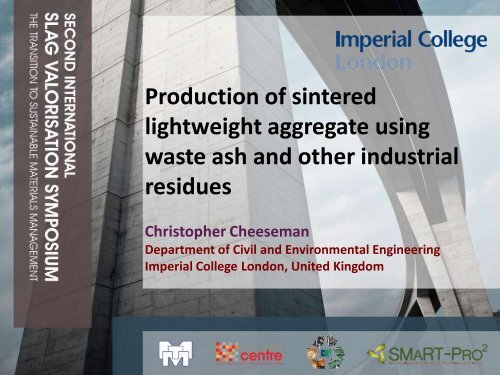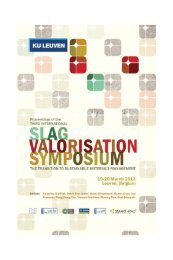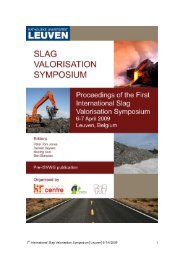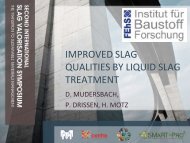Presentation - Third International Slag Valorisation Symposium
Presentation - Third International Slag Valorisation Symposium
Presentation - Third International Slag Valorisation Symposium
You also want an ePaper? Increase the reach of your titles
YUMPU automatically turns print PDFs into web optimized ePapers that Google loves.
Production of sintered<br />
lightweight aggregate using<br />
waste ash and other industrial<br />
residues<br />
Christopher Cheeseman<br />
Department of Civil and Environmental Engineering<br />
Imperial College London, United Kingdom
<strong>Presentation</strong> Outline<br />
Drivers for change and resource efficiency<br />
Overview on residues from thermal processes<br />
Lightweight aggregate<br />
Lytag manufactured from PFA, and why it is not ideal<br />
Examples of research: incinerator bottom ash and sewage sludge ash<br />
Conclusions<br />
2 Second <strong>International</strong> <strong>Slag</strong> <strong>Valorisation</strong> <strong>Symposium</strong> │ Cheeseman, Imperial College London
World population growth<br />
3<br />
http://www.worldometers.info/population/<br />
Second <strong>International</strong> <strong>Slag</strong> <strong>Valorisation</strong> <strong>Symposium</strong> │ Cheeseman, Imperial College London
CO 2 in the atmosphere<br />
4<br />
Second <strong>International</strong> <strong>Slag</strong> <strong>Valorisation</strong> <strong>Symposium</strong> │ Cheeseman, Imperial College London
Drivers for change<br />
Environmental<br />
issues<br />
Government<br />
Initiatives<br />
(EU and UK)<br />
Business<br />
Development<br />
and Innovation<br />
CO 2 emissions<br />
Climate change<br />
Population growth<br />
Exploitation of natural resources<br />
Increased cost of energy/transport<br />
Waste disposal tax<br />
CO 2 pricing<br />
Taxes on resource extraction<br />
Industrial symbiosis<br />
Resource efficiency<br />
Sustainable materials<br />
Low-carbon economy<br />
Second <strong>International</strong> <strong>Slag</strong> <strong>Valorisation</strong> <strong>Symposium</strong> │ Cheeseman, Imperial College London<br />
Page 5
6<br />
Mid 20 th century industry<br />
Natural<br />
resources<br />
Linear system<br />
Products<br />
Waste<br />
Second <strong>International</strong> <strong>Slag</strong> <strong>Valorisation</strong> <strong>Symposium</strong> │ Cheeseman, Imperial College London<br />
Courtesy of Peter Laybourn, NISP
Conventional primary raw materials<br />
Second <strong>International</strong> <strong>Slag</strong> <strong>Valorisation</strong> <strong>Symposium</strong> │ Cheeseman, Imperial College London<br />
Page 7
8<br />
Industrial symbiosis<br />
Natural resources<br />
Products<br />
Move toward<br />
Circular system<br />
Products<br />
Waste<br />
Natural resources<br />
Second <strong>International</strong> <strong>Slag</strong> <strong>Valorisation</strong> <strong>Symposium</strong> │ Cheeseman, Imperial College London<br />
To<br />
Resource<br />
Courtesy of Peter Laybourn, NISP
Wastes as important new resources<br />
Second <strong>International</strong> <strong>Slag</strong> <strong>Valorisation</strong> <strong>Symposium</strong> │ Cheeseman, Imperial College London<br />
Page 9
Materials flow for resource efficiency<br />
Natural<br />
Resources<br />
and Energy<br />
Materials<br />
Production<br />
Product<br />
Manufacturing<br />
Waste as<br />
Resources<br />
Product<br />
disposal<br />
as waste<br />
10 Second <strong>International</strong> <strong>Slag</strong> <strong>Valorisation</strong> <strong>Symposium</strong> │ Cheeseman, Imperial College London<br />
Product<br />
Use
11<br />
Residues from thermal processes<br />
Second <strong>International</strong> <strong>Slag</strong> <strong>Valorisation</strong> <strong>Symposium</strong> │ Cheeseman, Imperial College London
Residues from thermal treatment processes<br />
Coal power stations: Pulverised fuel ash (PFA)/fly ash<br />
Furnace bottom ash (FBA)<br />
Flue gas desulphurisation (FGD) waste<br />
Energy from waste: Incinerator bottom ash (IBA)<br />
Air pollution control (APC) residues<br />
Biomass ash: Incinerated sewage sludge ash (ISSA)<br />
Paper sludge ash (PSA)<br />
Wood and other biofuel ashes<br />
Steel industry: Ground granulated blast furnace slag (GGBS)<br />
Electric arc furnace (EAF) dust<br />
12<br />
Second <strong>International</strong> <strong>Slag</strong> <strong>Valorisation</strong> <strong>Symposium</strong> │ Cheeseman, Imperial College London
General characteristics and issues for reuse<br />
Glassy and/or crystalline, similar to volcanic ashes<br />
Aluminosilicate based, with residual carbon content and other contaminants<br />
Pozzolanic - potential for use as cement replacement materials<br />
Variable - waste residue, development of beneficiation processes<br />
Relatively low volumes in many cases<br />
Some may have fertiliser value<br />
May be hazardous wastes<br />
Concern over leaching into the environment<br />
ISCOWA - The <strong>International</strong> Society for the<br />
Environmental and Technical Implications of<br />
Construction with Alternative Materials<br />
13<br />
http://www.iscowa.org/<br />
Second <strong>International</strong> <strong>Slag</strong> <strong>Valorisation</strong> <strong>Symposium</strong> │ Cheeseman, Imperial College London
Technologies/materials processing<br />
Cement and concrete<br />
14<br />
Geopolymers<br />
Alkali-activated pozzolans<br />
Reuse by carbonation technologies<br />
Liquid phase sintering - ceramics/glass-ceramics<br />
Inorganic-organic composites<br />
Second <strong>International</strong> <strong>Slag</strong> <strong>Valorisation</strong> <strong>Symposium</strong> │ Cheeseman, Imperial College London
15<br />
Lightweight aggregate for structural<br />
lightweight concrete<br />
Second <strong>International</strong> <strong>Slag</strong> <strong>Valorisation</strong> <strong>Symposium</strong> │ Cheeseman, Imperial College London
Lightweight aggregate<br />
16<br />
� Granular material, typically 6-10mm diameter<br />
� Low density, ideally ~ 1.1-1.3 g/cm 3 but not < 1.0 g/cm 3<br />
(normal aggregate ~ 2.6 g/cm 3 )<br />
● Very low water absorption, ideally 0 wt.% but < 3 wt.%<br />
● High strength<br />
● Roughly spherical<br />
● Surface engineered to bond into concrete<br />
Second <strong>International</strong> <strong>Slag</strong> <strong>Valorisation</strong> <strong>Symposium</strong> │ Cheeseman, Imperial College London
Lightweight aggregate<br />
17<br />
Second <strong>International</strong> <strong>Slag</strong> <strong>Valorisation</strong> <strong>Symposium</strong> │ Cheeseman, Imperial College London
18<br />
Lightweight aggregate<br />
1. Natural materials<br />
Pumice, volcanic slags, expanded vermiculite<br />
2. Manufactured lightweight aggregate<br />
Expanded clay, shale or slate:<br />
Optiroc, Liapor, Perlite, Maxit - geotechnical uses<br />
Recycled glass: Poraver - lightweight thermally insulating products<br />
Sintered ash: Lytag - market leader for structural concrete<br />
Second <strong>International</strong> <strong>Slag</strong> <strong>Valorisation</strong> <strong>Symposium</strong> │ Cheeseman, Imperial College London
Lightweight aggregate applications<br />
Lightweight precast concrete products<br />
Off-site manufacturing<br />
Structural lightweight concrete<br />
Lightweight fill material<br />
Medium for water filtration<br />
Landscaping and drainage<br />
Agricultural and horticultural applications<br />
19<br />
Second <strong>International</strong> <strong>Slag</strong> <strong>Valorisation</strong> <strong>Symposium</strong> │ Cheeseman, Imperial College London
20<br />
Lightweight aggregate manufactured<br />
from pulverised fuel ash<br />
Second <strong>International</strong> <strong>Slag</strong> <strong>Valorisation</strong> <strong>Symposium</strong> │ Cheeseman, Imperial College London
Page 21<br />
Lytag<br />
One of the most successful ash derived construction products<br />
Uses pulverised fuel ash from coal fired power stations<br />
Relatively simple production process involving pan pelletising and sintering<br />
Low-energy as uses residual carbon in ash as fuel<br />
Second <strong>International</strong> <strong>Slag</strong> <strong>Valorisation</strong> <strong>Symposium</strong> │ Cheeseman, Imperial College London
Lytag manufacturing process<br />
Page 22<br />
Pan pelletiser<br />
PFA H 2O<br />
Mixer<br />
Pan Pelletiser<br />
Conveyor Belt<br />
Sinter Strand<br />
Sintered aggregate<br />
Grading<br />
LYTAG AGGREGATES (LWA)<br />
Second <strong>International</strong> <strong>Slag</strong> <strong>Valorisation</strong> <strong>Symposium</strong> │ Cheeseman, Imperial College London<br />
Sinter strand
Page 23<br />
Schematic of a sinter strand<br />
Second <strong>International</strong> <strong>Slag</strong> <strong>Valorisation</strong> <strong>Symposium</strong> │ Cheeseman, Imperial College London
Page 24<br />
Sinter strand<br />
Second <strong>International</strong> <strong>Slag</strong> <strong>Valorisation</strong> <strong>Symposium</strong> │ Cheeseman, Imperial College London
Fired density (g/cm³)<br />
3.0<br />
2.8<br />
2.6<br />
2.4<br />
2.2<br />
2.0<br />
1.8<br />
1.6<br />
1.4<br />
1.2<br />
1.0<br />
Effect of rapid and slow sintering<br />
1000 1050 1100 1150 1200 1250 1300 1350<br />
Temperature (°C)<br />
25<br />
Shrinkage (%)<br />
20.0<br />
18.0<br />
16.0<br />
14.0<br />
12.0<br />
10.0<br />
8.0<br />
6.0<br />
4.0<br />
2.0<br />
0.0<br />
Rapid sintering<br />
Conventional sintering<br />
Rapid sintering<br />
Conventional sintering<br />
1000 1050 1100 1150 1200 1250 1300 1350<br />
Temperature (°C)<br />
Effect of temperature on the fired density,<br />
shrinkage and water adsorption of rapid<br />
and slow sintered PFA pellets<br />
Second <strong>International</strong> <strong>Slag</strong> <strong>Valorisation</strong> <strong>Symposium</strong> │ Cheeseman, Imperial College London<br />
Water absorption (%)<br />
50.0<br />
45.0<br />
40.0<br />
35.0<br />
30.0<br />
25.0<br />
20.0<br />
15.0<br />
10.0<br />
5.0<br />
0.0<br />
1000 1050 1100 1150 1200 1250 1300 1350 1400<br />
Temperature (°C)<br />
Rapid sintering<br />
Conventional sintering
Microstructure of sintered PFA<br />
26<br />
Rapid sintered 1250°C Slow sintered 1250°C<br />
Second <strong>International</strong> <strong>Slag</strong> <strong>Valorisation</strong> <strong>Symposium</strong> │ Cheeseman, Imperial College London
Lightweight aggregate using<br />
incinerator bottom ash from energy<br />
from waste (EfW) plants<br />
27<br />
Second <strong>International</strong> <strong>Slag</strong> <strong>Valorisation</strong> <strong>Symposium</strong> │ Cheeseman, Imperial College London
Number of EfW plants in Europe<br />
28<br />
Number of<br />
facilities<br />
MSW<br />
Treated<br />
Mt per year<br />
France 130 12.3<br />
Germany 67 17.8<br />
Italy 51 4.0<br />
Sweden 30 4.5<br />
Switzerland 29 3.6<br />
UK 24 4.4<br />
Norway 20 0.8<br />
Belgium 16 2.6<br />
Netherlands 11 5.8<br />
Spain 10 1.8<br />
Austria 8 1.6<br />
Portugal 3 1.0<br />
Finland 1 0.05<br />
Poland 1 0.05<br />
Second <strong>International</strong> <strong>Slag</strong> <strong>Valorisation</strong> <strong>Symposium</strong> │ Cheeseman, Imperial College London<br />
MSW<br />
Municipal solid waste
Examples of UK EfW plants<br />
29<br />
Second <strong>International</strong> <strong>Slag</strong> <strong>Valorisation</strong> <strong>Symposium</strong> │ Cheeseman, Imperial College London
30<br />
UK Energy from waste (EfW) plants<br />
Source: Incineration Transformation, A.Metcalfe, CIWM, June 2010<br />
Second <strong>International</strong> <strong>Slag</strong> <strong>Valorisation</strong> <strong>Symposium</strong> │ Cheeseman, Imperial College London
31<br />
New proposed EfW facilities<br />
Source: Incineration Transformation, A.Metcalfe, CIWM, June 2010<br />
Second <strong>International</strong> <strong>Slag</strong> <strong>Valorisation</strong> <strong>Symposium</strong> │ Cheeseman, Imperial College London
Municipal Solid Waste as fuel<br />
32<br />
Second <strong>International</strong> <strong>Slag</strong> <strong>Valorisation</strong> <strong>Symposium</strong> │ Cheeseman, Imperial College London
Combustion at 900 to 1000°C<br />
33<br />
Second <strong>International</strong> <strong>Slag</strong> <strong>Valorisation</strong> <strong>Symposium</strong> │ Cheeseman, Imperial College London
Combustion grate<br />
34<br />
Second <strong>International</strong> <strong>Slag</strong> <strong>Valorisation</strong> <strong>Symposium</strong> │ Cheeseman, Imperial Collège London<br />
30% of waste input is IBA
Bottom ash recycling plant<br />
AGED<br />
RAW<br />
ASH<br />
MAGNET SCREEN<br />
FERROUS<br />
>20mm, ~ 15%<br />
8mm,
36<br />
Production process<br />
milling<br />
pelletising<br />
drying<br />
sintering<br />
Second <strong>International</strong> <strong>Slag</strong> <strong>Valorisation</strong> <strong>Symposium</strong> │ Cheeseman, Imperial College London<br />
LWA product
2<br />
1.9<br />
1.8<br />
1.7<br />
1.6<br />
1.5<br />
1.4<br />
1.3<br />
1.2<br />
1.1<br />
Key properties<br />
1<br />
990 1000 1010 1020 1030 1040 1050 1060<br />
15<br />
37<br />
Density<br />
Ly tag density data<br />
30<br />
25<br />
20<br />
10<br />
5<br />
0<br />
990 1000 1010 1020 1030 1040 1050 1060<br />
Water absorption<br />
Ly tag water<br />
absorption data<br />
Second <strong>International</strong> <strong>Slag</strong> <strong>Valorisation</strong> <strong>Symposium</strong> │ Cheeseman, Imperial College London<br />
10<br />
9<br />
8<br />
7<br />
6<br />
5<br />
4<br />
3<br />
2<br />
1<br />
compressiv e strength (MPa)<br />
0<br />
990 1000 1010 1020 1030 1040 1050 1060<br />
sintering temperature (degrees C)<br />
Compressive strength<br />
+ s.d.<br />
mean Ly tag data<br />
- s.d.
Microstructure<br />
38<br />
Microstructure of milled IBA pellet rapidly sintered at 1020°C<br />
Second <strong>International</strong> <strong>Slag</strong> <strong>Valorisation</strong> <strong>Symposium</strong> │ Cheeseman, Imperial College London
Lightweight aggregate manufactured<br />
from sewage sludge ash<br />
39<br />
Second <strong>International</strong> <strong>Slag</strong> <strong>Valorisation</strong> <strong>Symposium</strong> │ Cheeseman, Imperial College London
UK sewage sludge incinerators<br />
1. Beckton: East London<br />
2. Crossness: East London<br />
3. Roundhill: Stourbridge<br />
4. Coleshill: Birmingham<br />
5. Leeds<br />
6. Sheffield<br />
7. Huddersfield<br />
8. Bradford<br />
9. Widnes<br />
10. Belfast<br />
Second <strong>International</strong> <strong>Slag</strong> <strong>Valorisation</strong> <strong>Symposium</strong> │ Cheeseman, Imperial College London<br />
Page 40
UK sewage sludge incinerators<br />
41<br />
Second <strong>International</strong> <strong>Slag</strong> <strong>Valorisation</strong> <strong>Symposium</strong> │ Cheeseman, Imperial College London
Fluidised bed sludge incineration<br />
~100,000 tonnes of ISSA produced per year in the UK<br />
42<br />
Second <strong>International</strong> <strong>Slag</strong> <strong>Valorisation</strong> <strong>Symposium</strong> │ Cheeseman, Imperial College London
Blackburn Meadows SEM with EDS<br />
1000µm 200µm 60µm<br />
20µm<br />
Second <strong>International</strong> <strong>Slag</strong> <strong>Valorisation</strong> <strong>Symposium</strong> │ Cheeseman, Imperial College London<br />
Page 43
Crystalline phases<br />
44<br />
Second <strong>International</strong> <strong>Slag</strong> <strong>Valorisation</strong> <strong>Symposium</strong> │ Cheeseman, Imperial College London
1.6<br />
1.5<br />
1.4<br />
1.3<br />
1.2<br />
1.1<br />
1<br />
0.9<br />
Key ISSA lightweight aggregate properties<br />
Density<br />
1%clay 2%clay<br />
4%clay 8%clay<br />
16%clay Ly tag<br />
0.8<br />
1000 1020 1040 1060 1080<br />
10<br />
1100<br />
45<br />
40<br />
30<br />
20<br />
Ly tag density data<br />
Water absorption<br />
1%clay 2%clay 4%clay<br />
8%clay 16%clay Lytag<br />
0<br />
1000 1020 1040 1060 1080 8 1100<br />
Ly tag water<br />
absorption data<br />
0<br />
1000 1020 1040 1060 1080 1100<br />
Second <strong>International</strong> <strong>Slag</strong> <strong>Valorisation</strong> <strong>Symposium</strong> │ Cheeseman, Imperial College London<br />
10<br />
6<br />
4<br />
2<br />
Compressive strength<br />
1%clay 2%clay<br />
4%clay 8%clay<br />
16%clay Ly tag data<br />
Ly tag data
Effect of temperature on microstructure<br />
46<br />
1020°C<br />
1060°C<br />
Fracture surfaces of ISSA LWA pellets<br />
1070°C<br />
Second <strong>International</strong> <strong>Slag</strong> <strong>Valorisation</strong> <strong>Symposium</strong> │ Cheeseman, Imperial College London
Mechanisms occurring during rapid<br />
sintering of lightweight aggregate<br />
47<br />
Second <strong>International</strong> <strong>Slag</strong> <strong>Valorisation</strong> <strong>Symposium</strong> │ Cheeseman, Imperial College London
Microstructural control<br />
48<br />
Complex materials<br />
Number of interacting effects<br />
Reduced viscosity of the glass phase<br />
Liquid phase sintering<br />
Volatilisation of various components<br />
Internal oxidation and reduction reactions<br />
Formation of pozzolanic coating<br />
Second <strong>International</strong> <strong>Slag</strong> <strong>Valorisation</strong> <strong>Symposium</strong> │ Cheeseman, Imperial College London
Schematic microstructure 1<br />
Ideal lightweight aggregate<br />
� Strong core with uniform voids<br />
� Dense surface coating<br />
� Rough surface<br />
� Approximately spherical<br />
� 6 - 10 mm diameter<br />
� CaO rich surface coating<br />
� Black core due to reducing conditions<br />
49<br />
Second <strong>International</strong> <strong>Slag</strong> <strong>Valorisation</strong> <strong>Symposium</strong> │ Cheeseman, Imperial College London
Schematic microstructure 2<br />
Formation of connected porosity<br />
Results in high water absorption<br />
and reduced compressive strength<br />
Not ideal for structural concrete<br />
50<br />
Second <strong>International</strong> <strong>Slag</strong> <strong>Valorisation</strong> <strong>Symposium</strong> │ Cheeseman, Imperial College London
Schematic microstructure 3<br />
Marginally over-fired<br />
Exaggerated growth of voids<br />
Low density<br />
High water absorption<br />
Cannot be used for structural concrete<br />
51<br />
Second <strong>International</strong> <strong>Slag</strong> <strong>Valorisation</strong> <strong>Symposium</strong> │ Cheeseman, Imperial College London
Schematic microstructure 4<br />
Over-fired lightweight aggregate<br />
Bloated<br />
Low density<br />
Low strength<br />
High water absorption<br />
52<br />
Second <strong>International</strong> <strong>Slag</strong> <strong>Valorisation</strong> <strong>Symposium</strong> │ Cheeseman, Imperial College London
Schematic microstructure 5<br />
Over-bloated aggregate<br />
Extremely lightweight<br />
Over fired<br />
Extremely low density<br />
Very low strength<br />
High water absorption<br />
53<br />
Second <strong>International</strong> <strong>Slag</strong> <strong>Valorisation</strong> <strong>Symposium</strong> │ Cheeseman, Imperial College London
54<br />
Conclusions<br />
Important drivers for increased resource efficiency<br />
Beneficial reuse of residues from thermal treatment processes<br />
Lightweight aggregate - Lytag from pulverised fuel ash<br />
Other options using relatively simple processing<br />
Control of mix design and processing<br />
Engineered lightweight products with improved performance<br />
Second <strong>International</strong> <strong>Slag</strong> <strong>Valorisation</strong> <strong>Symposium</strong> │ Cheeseman, Imperial College London
Acknowledgements<br />
The conference organisers and sponsors – Thank you<br />
PhD students and Post Doctoral Researchers: Amutha Deveraj, Nikolaos<br />
Vlasopoulos, Marta Pellizon Birelli, Nicola Bianco, Rosie Greaves Shane Donatello, Abdelhamid<br />
Beshara, Babagana Mohammed, Ioanna Kourti, Carsten Kuenzel, Tingting Zhang, Fei Zhang,<br />
Christos Lampris, Christine Dimech, Vanessa Adell, Richard Lupo<br />
Research Collaborators: Aldo Boccaccini, Luc Vandeperre, Mark Tyrer, Julia Stegemann,<br />
Chi Poon, David Wilson, Bill Townend, Xuichen Qiao, Geoff Fowler, Kung-Yuh Chiang<br />
Research Sponsors: Technology Strategy Board, EPSRC, Defra-BREW, Egyptian<br />
Government, PTDF Nigeria<br />
Industrial Sponsors: Tetronics Ltd, Rio Tinto Minerals, Laing O’Rourke, Duo, Walsh,<br />
Veolia Environmental, SELCHP, Claylite Aggregates, Akristos, Bob Martin, Ballast Phoenix,<br />
Grundon Waste Management, UKQAA, BCA, Elkem, NISP, WRAP, Imperial Innovations<br />
For more information please contact: c.cheeseman@imperial.ac.uk<br />
Second <strong>International</strong> <strong>Slag</strong> <strong>Valorisation</strong> <strong>Symposium</strong> │ Cheeseman, Imperial College London<br />
Page 55







